| A Polish Academic Information Center Exhibit |
| |
POZNAŃ: The legendary
cradle of Poland
Click on visuals for additional information
A city of 600,000 inhabitants, Poznań lies in the western part of Poland and is the capital of the region known as Wielkopolska, a term frequently translated as Great Poland, but likely a reference of the large fields (Wielkie Pola) common to this relatively flat region. The city itself has an interesting history and is rich in places of interests that reflect that history: churches, palaces, musea and monuments. For all of that, it is also a flourishing metropolis know, the world over, for its trade-fairs. Here, in largest trade fair complex in Poland, over 25 events such as Budma, an international construction fair, and Polagra, Europe's largest agro-industrial show, are staged annually. However, for those more interested in tourism, the city offers many historical landmarks that are well worth seeing.
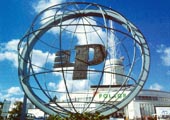
International Fair Complex |

The Cathedral |

Mieszko I
Bolesław I |
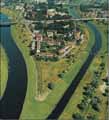
Ostrów Tumski |

Economics Academy |
|
Poznań lies on the Warta River and the most ancient part of the city is the Cathedral Island or, as it is to this day rendered in rather archaic Polish, Ostrów Tumski. It is on this island that there once stood the castle of Prince Mieszko I who accepted Christianity on behalf of the Polish nation in 966, and of his son, Bolesław the Brave, Poland's first crowned king. The sarcophaguses of father and son can be viewed in the Gold Chapel of the gothic cathedral that stands on the island to this day. Near the cathedral stands the Museum of the Archdiocese. It houses, in addition to gold chalices and monstrances from the churches of Wielkopolska, Poland's only paintings by Anthony Van Dyck. The observation terrace of the Economics Academy's skyscraper, 260 feet high, offers an excellent view of Ostrów Tumski and the cathedral.
To the west of the river is the center of the old city, the Stary Rynek, or Old Market Square in the middle of which stands the Renaissance Town Hall. Until 1939, it housed the city's government. Today, the building is home to the Poznań Historical Museum. At noon, two mechanical billy goats clash horns on the Town Hall tower. Inside is the lavishly decorated Great Hall. The facades of the houses surrounding the square, and the ones abutting the Town Hall - once the homes of the wealthiest residents - feature Renaissance and Baroque motifs. Three of these buildings now house the Museum of Musical Instruments, with exhibits from all over the world and from many musical eras.

Renaissance Town Hall |
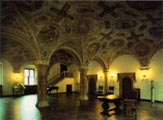
The Renaissance Hall |

Górka Palace |

The Fara Church |
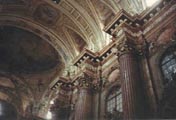
Fara Church Interior |
|
Not far from the Stary Rynek stands Poznań's most beautiful church, the huge Baroque Parish Church of St. Stanislaus, commonly referred to as the Fara Church. This is one of Poznań's most mysterious buildings, since parts of the crypts have not yet been investigated. Rumors say that crates of sketches by the great Polish painters Jan Matejko and Wojciech Gerson, purchased for the Poznań City Museum just before World War II, were hidden here. Every day during the summer, organ concerts are held in the church with the proceeds going towards the renovation of its historic organ.
On the hill next to the Market Square are the foundations of the castle of Przemysł II (1257-1296), Duke of Wielkopolska who was crowned King of Poland in 1295 only to be assasinated by agents of the Brandeburgs a year later. Built in the second half of the 13th century, the castle remained a royal seat for many years. It was here in 1493 that King Jan Olbracht accepted the homage of the grand master of the Teutonic Knights, Johann von Tiefen. The building fell into ruin in the 18th century, and on its foundations the Prussians later erected a new building. It was destroyed in 1945. Reconstructed after the war, it now houses the Museum of Applied Art.
Further west is another Poznań square that commands attention, namely Plac Wolności (Liberty Square). It is dominated by the Raczyński Library, the public library founded in Poznań in the early 19th century by Edward Raczyński. Its facade is an architectural reference to the eastern facade of the Louvre. Also located on the square is Poznań National Museum which boasts Poland's largest collection of works by the painter Jacek Malczewski. Its permanent exhibition of Gothic art is also worth seeing. From the west, the square is completed by the former German theater where Teatr Ósmego Dnia (The Theater of the Eighth Day) is located today.
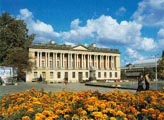
Raczyński Library |

National Museum |

Hotel Bazar
in 1918 |
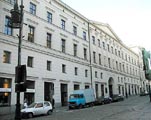
The Bazar building
today |
|
Adjoining the square is the building that once housed the Bazar Hotel. Built in 1838-42 during the period of the partitions when this area of Poland was under Prussian occupation, it was the site of patriotic ceremonies, speeches, concerts and balls. During the 1948 Spring of Nations it was the headquarters of the National Committee during the attempted uprising. On December 26, 1918 and while Poznań remained in German hands, it was from a window of the Hotel that Paderewski, the famous pianist and patriot who had on that day returned to Poland, spoke to a huge patriotic throng which gathered to welcome him. It was also here that the following day, while preparations were underway for a banquet honoring Paderewski, that shots fired at the Hotel from a German counter-demonstration. This proved the spark that led to an uprising by Polish patriots that led, over the following two months to the territory of Wielkopolska becoming part of the renascent Polish state.

The Okrąglak |
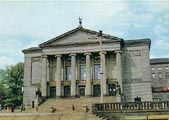
The Opera |
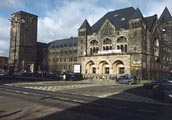
Imperial Palace |
|
Next door is the Okrąglak, Poland's only round department store. Its windows offer an excellent view of the Opera, which is referred to as the Teatr Wielki, or Grand Theater. It was Poland's first permanent opera house dating from 1910. Today it stages excellent productions and has a prominent decorative element- the winged horse Pegasus.
The opera house was one of a number of important elements of the new city center designed in the early 20th century and located even further to the west. The center's main building is still the Imperial Palace built, in neo Romanesque style, by Kaiser Wilhelm II. This was the last royal residence of such size built in Europe. In the courtyard is the Lion Fountain - a replica of the famous sculpture from the Alhambra. The Kaiser, who visited his castle just twice, received guests in the throne room, which today houses a movie theater.
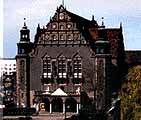
Adam Mickiewicz University |

June '56
Memorial |

Wielkopolska Uprising Memorial |
|
For those who enjoy longer outings, the Wielkopolski National Park, just a dozen or so miles from Poznań, is an excellent choice. Napoleon Bonaparte stayed there in the early 19th century. A stroll around Poland's oldest and largest palm house or a visit to one of two zoos is ideal for those who don't have time for long excursions. Poland's oldest zoological garden. was established in 1874 with a donation of a few animals. With time, the modest collection grew into a large animal farm.
Poznań has no shortage of artistic attractions. In January, numerous choirs give concerts of Christmas carols. In late June there is the Malta
International theater Festival or a concert by the excellent boys' choir, the Poznań Nightingales. Organ concerts are held in St. Stanislaus Parish Church from July to Sept. at 12:15 p.m.
There are plenty of palaces and castles to see around Poznań. South of the city is the palace in Rogalin, surrounded by a beautiful park. It includes a museum and a gallery of paintings. Old furniture and fittings have been preserved in the castle in Kórnik, which houses a collection of national mementos and is surrounded by a beautiful arboretum.
Page generated by Peter Gessner on the basis of an article by Wiesia Abczynski
.
| Links |
Size |
Comments |
| We are the Economic center
|
590 words |
An article about the city by its mayor, Ryszard Grobelny |
| The Beautiful City of Poznan, Poland
|
670 words |
An overview of the city offered by the English Language program of the Medical University |
| Poznan Multimedia City Guide |
90 webpages |
A somewhat abbreviated English language (19 webpages) and a more extensive Polish language (70 webpages) guide, providing extensive well structured information. |
| Welcome to the Poznan City Guide
|
40+ webpages |
Overview; Interactive City Map; Photo Gallery; Transportations, Accommodations and Entertainment; |
| Mapy |
Eight maps |
Historical maps of Poznań from the 13th century through 1973 (section of larger website) |
| Poznan w 1945 roku
|
25 photos |
Photographs of the devastation that WWII visited upon the city. Part of a larger website |
|
|



















